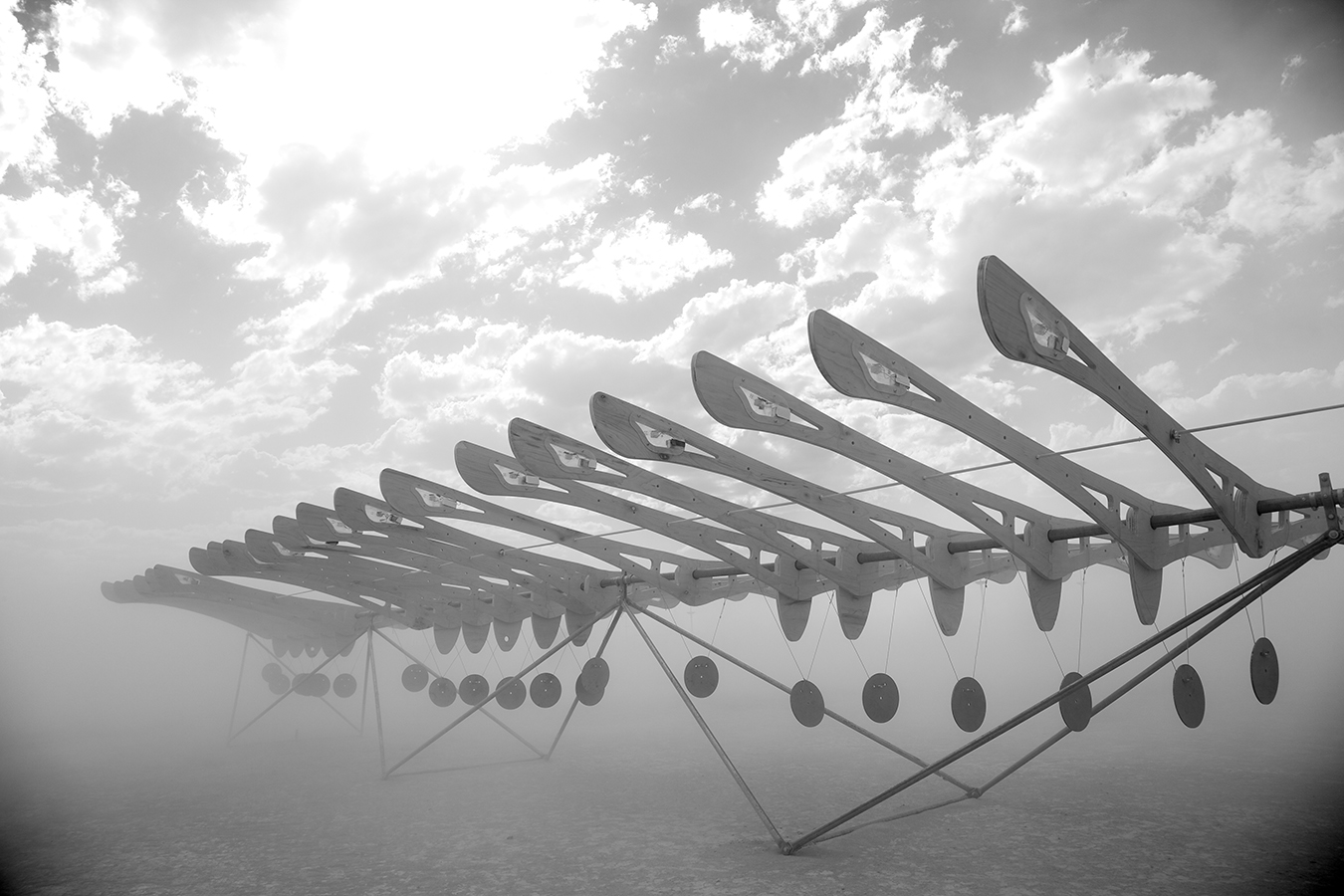Ginkgo.Your Innovation Partner.

The Ginkgo Creative Residency exists as a platform that genuinely integrates innovative, creative practice with the technical and industrial realm of biology. Following an open call that attracted applicants from 14 countries over five continents, encompassing creative disciplines as diverse as film, gastronomy, experience and textile design, we are thrilled to welcome Andrea Ling as Ginkgo’s 2019 Creative Resident! During her three month residency at Ginkgo, Andrea will develop a new project that explores the design of decay using biology as an agent for material transformation.
Andrea is an architect and artist working at the intersection of design, fabrication, and biology. A maker of process before form, and, in working with autonomous organisms as design partners, Andrea has a special interest in how designers might accommodate variation and agency within the design process and the resulting cultural implications of this accommodation that might arise. Her work, both solo and group, ranges from wearable sculpture to large-scale public art installations with a focus on immersive work that affects the bodily experience and exhibits responsivity.
Andrea obtained her MS from MIT and her M.Arch from the University of Waterloo with a background in human physiology from the University of Alberta. On becoming a member of the Mediated Matter group, her research into biologically mediated design processes began to shift to focus on living systems as a medium for design expression, and as a viable way of constructing responsive material relationships between body and environment.
[caption id="attachment_3517" align="aligncenter" width="1350"] Decomposing maquette, 2018. 3D-printed chitosan, cellulose, and pectin composites, water.[/caption]
Decomposing maquette, 2018. 3D-printed chitosan, cellulose, and pectin composites, water.[/caption]
[caption id="attachment_3522" align="aligncenter" width="1600"] Templating fungal growth, 2018. Chitosan, cellulose, vermiculite, brown rice, pink oyster mushroom spores.[/caption]
Templating fungal growth, 2018. Chitosan, cellulose, vermiculite, brown rice, pink oyster mushroom spores.[/caption]
Andrea’s thesis project, Design by Decay, Decay by Design (2016 - 2018) focuses on integrating decay as an element of the functional and aesthetic capacity of an object. The resulting experimental artefacts constructed with mostly 3D printed structural polysaccharides whose degradation rate is influenced by material composition, geometry, and water content, introducing natural decay as a design parameter as much as characteristics such as colour, opacity, and strength. The project is a part of Mediated Matter group’s ongoing research on the ecological cycle of materials and biologically mediated design processes.
Also as a part of Mediated Matter group’s Silk Studies (2018), Andrea has explored a set of behavior characterization, showing how silkworms can create planar textiles when provided specific base parameters during their spin phase. Adjustable variables in these samples include surface area, location and height of physical obstacles, perimeter geometry, and span distances.
[caption id="attachment_3530" align="aligncenter" width="1600"] Vertical scaffold, 2018. Silk worm, 3D printed poles, silk fiber, cotton thread.[/caption]
Vertical scaffold, 2018. Silk worm, 3D printed poles, silk fiber, cotton thread.[/caption]
[caption id="attachment_3529" align="alignnone" width="1600"] Patterned obstacles, 2018. Silk worms, paper, acrylic templates, silk fiber deposition.[/caption]
Patterned obstacles, 2018. Silk worms, paper, acrylic templates, silk fiber deposition.[/caption]
Andrea's innate understanding of design and fabrication at multiple scales is further exemplified through a portfolio of projects by designGUILD, an artist collective she co-founded in 2011. Working on large-scale kinetic and responsive public art projects, designGUILD maximizes spatial connection and interactivity between the spectators/participants and the sculptures, such that there is a dynamic exchange between the two. The collective has been commissioned for temporary installations for festivals such as Burning Man and Nuit Blanche as well as permanent work for municipal clients.
[caption id="attachment_3532" align="aligncenter" width="1600"] Renderings & construction drawings, 2014. Andrea Ling, Jonah Humphrey, Spencer Rand, Patrick Svilans. Commissioned proposal for Traffic Triangle at Bathurst St & Vaughan Rd, Toronto. CNC cut aluminum & high-density polyurethane bird forms with high-gloss finish, rotating painted stainless-steel spine, gear system enclosed in painted stainless-steel columns.[/caption]
Renderings & construction drawings, 2014. Andrea Ling, Jonah Humphrey, Spencer Rand, Patrick Svilans. Commissioned proposal for Traffic Triangle at Bathurst St & Vaughan Rd, Toronto. CNC cut aluminum & high-density polyurethane bird forms with high-gloss finish, rotating painted stainless-steel spine, gear system enclosed in painted stainless-steel columns.[/caption]
[caption id="attachment_3535" align="aligncenter" width="1350"] Through the Gorilla Glass (TTGG) Burning Man – Site installation 2012. Andrea Ling, Jonah Humphrey, Spencer Rand, Patrick Svilans, Johnathon Wong. Poplar plywood, laser cut steel discs, galvanized steel tubing, cotton rope, bungee, LED light units on acrylic plates. 120’L x 10’W x 4’H.[/caption]
Through the Gorilla Glass (TTGG) Burning Man – Site installation 2012. Andrea Ling, Jonah Humphrey, Spencer Rand, Patrick Svilans, Johnathon Wong. Poplar plywood, laser cut steel discs, galvanized steel tubing, cotton rope, bungee, LED light units on acrylic plates. 120’L x 10’W x 4’H.[/caption]
[caption id="attachment_3536" align="aligncenter" width="1350"] Burning Man –Site installation 2012.[/caption]
Burning Man –Site installation 2012.[/caption]
Unlike previous open calls that invited participants to submit a proposal based on a subject of their choosing, this year, applicants of the Ginkgo Creative Residency were asked to respond specifically to the issue of waste streams. We've focused the theme of the residency on waste given the immediate urgency of this global problem, and to develop a holistic approach to thinking about technological innovation in this realm. We are excited to see how Andrea's thinking and design process expands our understanding of how synthetic biology could interact with efforts to design, biofabricate and scale circular material flows!
During her residency, Andrea will receive mentorship from the creative team at Ginkgo Bioworks, Faber Futures’ founder Natsai Audrey Chieza and Biofabricate’s producer Amy Congdon. This year, we have also invited an expert jury to offer our resident with critical perspectives on the complex and multifaceted topic of waste. We welcome LinYee Yuan, Founder & Editor MOLD, and Emeka Okafor curator of TEDGlobal, Co-Founder the TED Fellows program and Maker Faire Africa, who will also be providing mentorship on the programme.
We’ll be sharing updates on Andrea’s time at Ginkgo here on the blog and on the Ginkgo Creative Residency Instagram page @ginkgocreativeresidency.
Posted by Christina Agapakis